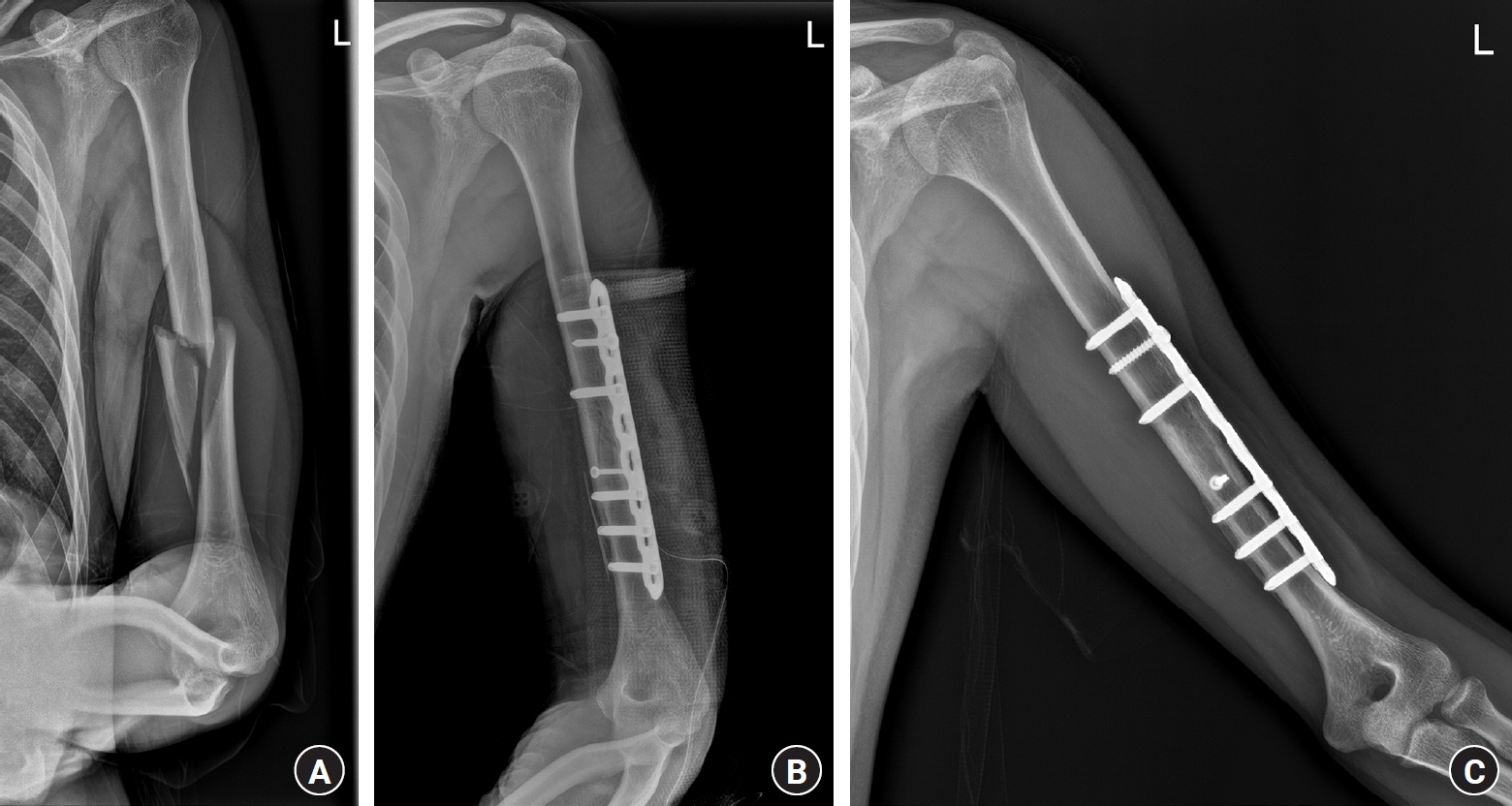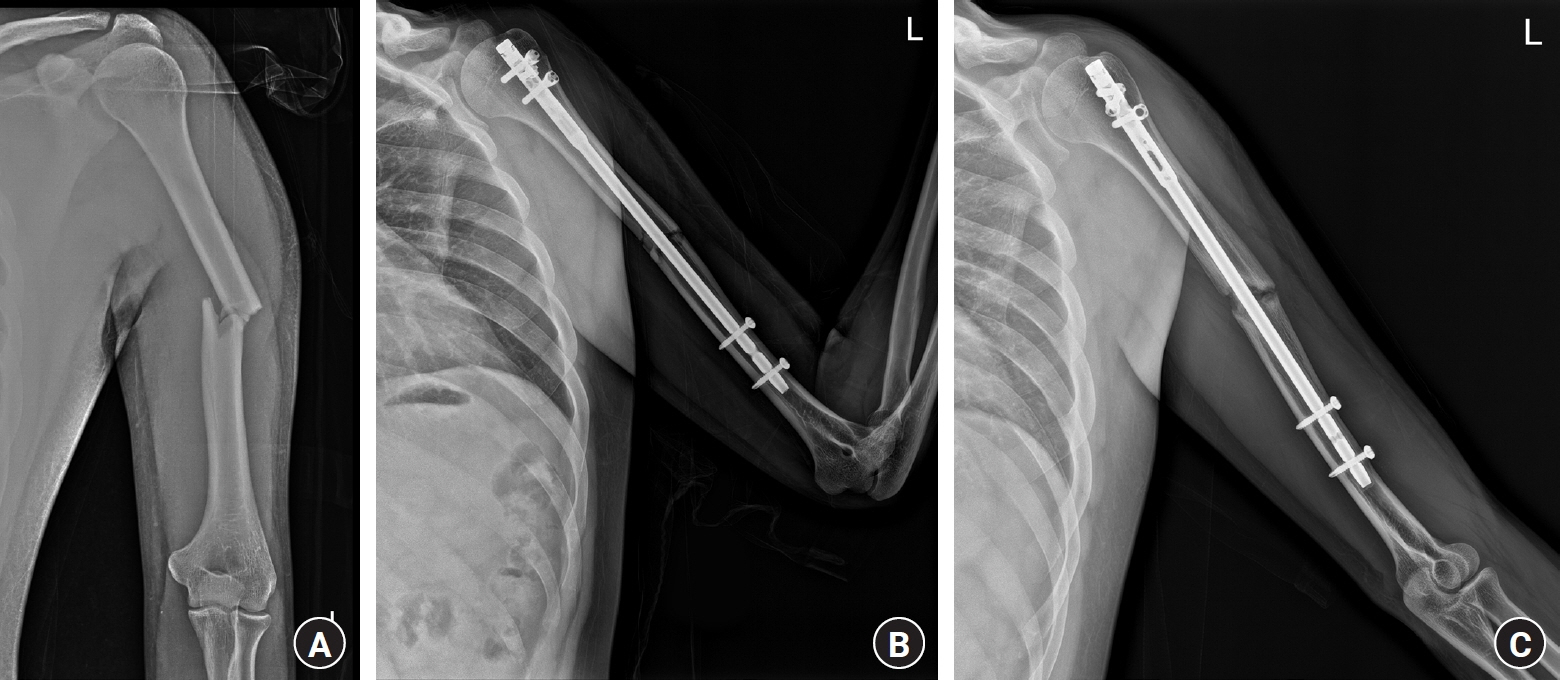Arch Hand Microsurg.
2023 Dec;28(4):260-266. 10.12790/ahm.23.0036.
Epidemiological characteristics and surgical outcomes of traumatic humeral shaft fractures in Korean soldiers
- Affiliations
-
- 1Department of Orthopedic Surgery, Wonkwang University Sanbon Hospital, Gunpo, Korea
- 2Department of Orthopedic Surgery, Armed Forces Daejeon Hospital, Daejeon, Korea
- KMID: 2548597
- DOI: http://doi.org/10.12790/ahm.23.0036
Abstract
- Purpose
We investigated the epidemiological characteristics and surgical results of traumatic humeral shaft fractures in young adults in the Korean military and explored whether there were differences depending on the cause of fracture.
Methods
Patients with traumatic humeral shaft fractures who visited the emergency room or outpatient department of Armed Forces Daejeon Hospital (AFDH) after enlistment between May 2019 and October 2021 were included. Medical records were retrospectively reviewed, and demographic data, fracture patterns, injury mechanisms, and complications were investigated. The time to union, follow-up period, and Disabilities of the Arm, Shoulder, and Hand questionnaire (DASH) scores were additionally analyzed in patients who underwent surgical treatment at AFDH.
Results
In total, 31 patients with traumatic humeral shaft fractures were included. Arm wrestling (17 patients, 54.8%) was the most common cause of fractures. The patients were divided into arm-wrestling patients (n=17) and other patients (n=14) for comparison. No significant differences in fracture patterns and complications were found between these groups. The mean time to bone union was 12.08±1.32 weeks and the final DASH score was 11.01±13.51.
Conclusion
Arm wrestling was identified as the most common cause of humeral shaft fractures among soldiers in South Korea. We found no significant differences in the patterns of humeral shaft fractures caused by arm wrestling and those with other causes.
Figure
Reference
-
References
1. Mattila H, Keskitalo T, Simons T, Ibounig T, Rämö L. Epidemiology of 936 humeral shaft fractures in a large Finnish trauma center. J Shoulder Elbow Surg. 2023; 32:e206–15.
Article2. Ekholm R, Adami J, Tidermark J, Hansson K, Törnkvist H, Ponzer S. Fractures of the shaft of the humerus: an epidemiological study of 401 fractures. J Bone Joint Surg Br. 2006; 88:1469–73.3. Mahabier KC, Vogels LM, Punt BJ, Roukema GR, Patka P, Van Lieshout EM. Humeral shaft fractures: retrospective results of non-operative and operative treatment of 186 patients. Injury. 2013; 44:427–30.
Article4. Bergdahl C, Ekholm C, Wennergren D, Nilsson F, Möller M. Epidemiology and patho-anatomical pattern of 2,011 humeral fractures: data from the Swedish Fracture Register. BMC Musculoskelet Disord. 2016; 17:159.
Article5. Court-Brown CM, Caesar B. Epidemiology of adult fractures: a review. Injury. 2006; 37:691–7.
Article6. Tytherleigh-Strong G, Walls N, McQueen MM. The epidemiology of humeral shaft fractures. J Bone Joint Surg Br. 1998; 80:249–53.
Article7. Tsai CH, Fong YC, Chen YH, Hsu CJ, Chang CH, Hsu HC. The epidemiology of traumatic humeral shaft fractures in Taiwan. Int Orthop. 2009; 33:463–7.
Article8. Kim SH, Szabo RM, Marder RA. Epidemiology of humerus fractures in the United States: nationwide emergency department sample, 2008. Arthritis Care Res (Hoboken). 2012; 64:407–14.
Article9. Chao SL, Miller M, Teng SW. A mechanism of spiral fracture of the humerus: a report of 129 cases following the throwing of hand grenades. J Trauma. 1971; 11:602–5.10. Pehlivan O, Kiral A, Akmaz I, Solakoglu C, Arpacioglu O, Kaplan H. Humeral shaft fractures secondary to throwing. Orthopedics. 2003; 26:1139–41.
Article11. Kim KE, Kim EJ, Park J, Kim SW, Kwon J, Moon G. Humeral shaft fracture and radial nerve palsy in Korean soldiers: focus on arm wrestling related injury. BMJ Mil Health. 2021; 167:80–3.
Article12. Mahabier KC, Van Lieshout EM, Van Der Schaaf BC, et al. Reliability and reproducibility of the OTA/AO classification for humeral shaft fractures. J Orthop Trauma. 2017; 31:e75–80.
Article13. Mayfield CK, Egol KA. Humeral fractures sustained during arm wrestling: a retrospective cohort analysis and review of the literature. Orthopedics. 2018; 41:e207–10.
Article14. Moon MS, Kim I, Han IH, Suh KH, Hwang JD. Arm wrestler’s injury: report of seven cases. Clin Orthop Relat Res. 1980; (147):219–21.15. Ogawa K, Ui M. Humeral shaft fracture sustained during arm wrestling: report on 30 cases and review of the literature. J Trauma. 1997; 42:243–6.16. Pedrazzini A, Pedrazzoni M, De Filippo M, Nicoletto G, Govoni R, Ceccarelli F. Humeral fractures by arm wrestling in adult: a biomechanical study. Acta Biomed. 2012; 83:122–6.17. Hendrickx LA, Hilgersom NF, Alkaduhimi H, Doornberg JN, van den Bekerom MP. Radial nerve palsy associated with closed humeral shaft fractures: a systematic review of 1758 patients. Arch Orthop Trauma Surg. 2021; 141:561–8.
Article18. Holstein A, Lewis GM. Fractures of the humerus with radial-nerve paralysis. J Bone Joint Surg Am. 1963; 45:1382–8.
Article19. Ekholm R, Ponzer S, Törnkvist H, Adami J, Tidermark J. The Holstein-Lewis humeral shaft fracture: aspects of radial nerve injury, primary treatment, and outcome. J Orthop Trauma. 2008; 22:693–7.
Article20. Updegrove GF, Mourad W, Abboud JA. Humeral shaft fractures. J Shoulder Elbow Surg. 2018; 27:e87–97.
Article21. Claessen FM, Peters RM, Verbeek DO, Helfet DL, Ring D. Factors associated with radial nerve palsy after operative treatment of diaphyseal humeral shaft fractures. J Shoulder Elbow Surg. 2015; 24:e307–11.
- Full Text Links
- Actions
-
Cited
- CITED
-
- Close
- Share
- Similar articles
-
- Humerus Shaft Fracture Caused by Arm Wrestling Injury in South Korean Military: Surgical Outcome and Radiologic Analysis
- Polarus Intramedullary Nail for Proximal Humeral and Humeral Shaft Fractures in Elderly Patients with Osteoporosis
- The Fractures of Humerus Shaft and Medial Epicondyle by Arm Wrestling
- Delayed Brachial Artery Occlusion after Humeral Shaft Open Fracture: A Case Report
- Short Humeral Stems in Shoulder Arthroplasty




